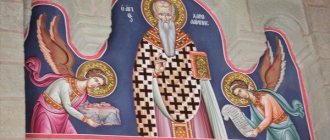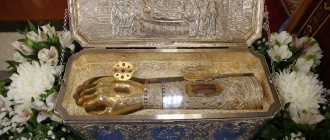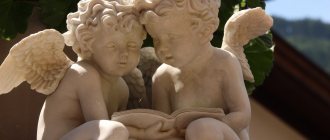| Sschmch. Dionysius the Areopagite. Icon |
Dionysius the Areopagite
(c.), Bishop of Athens, Hieromartyr Commemoration of October 3 and the Council of the 70 Apostles
Lived in the city of Athens. There he was brought up and received a classical Hellenic education. Then he went to Egypt, where he studied astronomy in the city of Iliopolis. Together with his friend Apollophon, he witnessed a solar eclipse at the time of the crucifixion of the Lord Jesus Christ. “It is either God, the Creator of the whole world, who suffers, or this visible world ends,” Dionysius said then. In Athens, where he returned from Egypt, he was elected a member of the Areopagus (the supreme court of Athens).
When the holy Apostle Paul preached in the Athenian Areopagus (Acts 17: 16 - 34), Dionysius accepted this saving gospel and became a Christian.
In Acts. 17, 34, together with Dionysius the Areopagite, Damara is mentioned, whom some consider the wife of Dionysius.
For three years, Dionysius was a companion of the holy Apostle Paul in preaching the Word of God. Subsequently, the Apostle Paul made him bishop of the city of Athens. In the year Saint Dionysius was present at the burial of the Most Holy Theotokos.
Even during the life of the Mother of God, Dionysius the Areopagite, who specially came to Jerusalem from Athens to see the Mother of God, wrote to his teacher the Apostle Paul:
“I am testified by God that, besides God Himself, there is nothing in the universe so filled with Divine power and grace. No man can comprehend with his mind what I saw. I confess before God: when I was brought before the face of the Blessed Virgin by John, shining among the apostles, like the sun in the sky, I experienced an inexpressible feeling. Some kind of Divine radiance shone before me. It illuminated my spirit. I felt the fragrance of indescribable aromas and was filled with such delight that neither my weak body nor my spirit could bear these signs and the firstfruits of eternal bliss and Heavenly glory. From Her grace my heart fainted, my spirit fainted. If I had not remembered your instructions, I would have considered Her to be the true God. It is impossible to imagine greater bliss than what I felt then.”
| The Torment of St. Dionysius the Areopagite. Fresco. Athos, Dionysiates Monastery (1547 by Zorzis Fuka) |
He died a martyr's death (according to ancient news, based on the testimony of the apologist Aristides). There is an opinion dating back to the Middle Ages, according to which Dionysius the Areopagite was a preacher of Christianity in Gaul (See Dionysius of Paris).
Patron Saint Denisov
The name “Dionysius” in Russian transcription sounds like “Denis”. Many have him as their heavenly patron. But not all of them, since other saints also bear the name Dionysius.
How, then, can we determine which of our Denisovs has a name day on October 16? There is such a rule for determining this Day. It is necessary to look at the church calendar to see which commemoration of our namesake saint will be closest to our birthday. This saint is our heavenly patron.
Therefore, everyone born from September 1 to October 16 is patronized by the holy martyr Dionysius the Areopagite.
The rest of the Denises, born from October 17 to August 31 (this is the day of remembrance of the martyr Dionysius of Trebia), have other Dionysias as their patrons.
St. Dionysius of Alexandria
(died c. 265), Bishop of Alexandria, Father of the Church. Born at the end of the 2nd century. in a noble family. He converted to Christianity as an adult. Dionysius studied with Origen at the Alexandrian catechetical school, which he later (c. 231) headed. It was probably during this period that he wrote a treatise devoted to the systematic refutation of the atomistic teaching of Epicurus and his followers. In 247 or 246 Dionysius became bishop of Alexandria and patriarch of northeast Africa. In 248, popular unrest against Christians broke out in Alexandria, and in 249, the persecution of Decius began. Dionysius escaped imprisonment by hastily leaving Alexandria, but he had to endure many hardships and hardships in the Libyan desert before he could return to Alexandria (probably in 251).
Also on topic:
BISHOP
In subsequent years, Dionysius played an important role in all the events that worried the Christian community of that time. First of all, he was a spiritual shepherd, and he owns many epistles that treat issues of dogma and church politics. Thus, in his message regarding those who had abandoned the Christian faith, he called for leniency towards the weakness of these people - subject to their sincere repentance. Thanks to his efforts, many inveterate schismatics returned to the fold of the church. On the issue of rebaptizing those who had been baptized by heretics, he took a moderate position, urging both disputing parties to refrain from extreme and violent measures. He was the first to condemn the Sabellian heresy, which had spread in Pentapolis, which was under his episcopal jurisdiction. Apparently, he was the first to introduce holiday pastoral messages into use, which touched upon pressing problems of church life; this practice became a distinctive feature of the administrative structure of the Egyptian Church.
In 257, when the persecution of Emperor Valerian began, Dionysius, along with other clergy, had to appear before the court of the provincial prefect. For his testimony of faith, he was sent into exile by the imperial authorities, first to Kefron on the border of the Libyan Desert, then to Kollufion, and then to a small village in the vicinity of Lake Mareot. All these movements were associated with suffering and hardship. When peace was restored under Emperor Gallienus, Dionysius returned to Alexandria. Dionysius of Alexandria died c. 265. Memorial Day of the Saint November 17 (in the Russian Orthodox Church September 6 according to the old style).
Companion of Saint Paul. Apostle from 70
This is stated in the Holy Scriptures. After the sermon of the Apostle Paul in the Athens Areopagus, the majority of those present there did not want to listen to him. But, however, as it says in the Acts of the Apostles: “Some men came to him and believed; among them was Dionysius Apeopagite and a woman named Damar, and others with them” (Acts 17: 34).
Sermon by Ap. Paul on the Areopagus. Painting of the church of Pentelis Monastery. Artist Spyros Vasiliou. XX century
Damar is the wife of Dionysius himself. And since then, leaving his wife and family, he became one of the closest disciples of the apostle. Pavel. Enlightened by his inspired words, he not only accepted baptism, becoming a Christian, but for his equal-to-the-apostles deeds in the field of Christian preaching, he was numbered by the Lord among the seventy apostles.
Missionary activities
In Jerusalem, the inspired speeches of the Holy Apostles, the vision of the Dormition of the Mother of God, the sight of Golgotha and other shrines made Dionysius experience such strong inner experiences that he decided to leave his fatherland and his relatives forever and go to preach the Gospel to pagan countries. He returned to Athens only to take several clerics with him. Further, his path lay in Western Europe, where idolatry flourished, where he glorified Jesus Christ with word, signs and wonders. He illuminated Italy, Spain, Germany and Gaul with the light of the Gospel until he died in Paris, in the one hundred and tenth year of Christ. On October 3, the Church celebrates the memory of such a famous figure of early Christianity as Saint Dionysius the Areopagite.
Life of a Philosopher
The saint was born in the sixth or seventh year A.D., from noble and noble parents. He studied science, primarily philosophy, in Athens, which was famous for its philosophical schools.
The philosophy of that time, having given rise to many different schools, came to skepticism, which denied the possibility of knowing the truth and even its existence. Ancient philosophers came to this wrongful conclusion that truth is supposedly unknowable or does not exist at all.
Only Socrates doubted this, who humbly asserted that he “knows that he knows nothing.” Dionysius, who by the age of 25 had achieved brilliant success in the knowledge of science, in philosophy did not adhere to generally accepted skepticism, but rather Socratic doubt. Which subsequently affected his theology.
Observed a solar eclipse at the moment when Christ was crucified
Wanting to further improve his knowledge, the saint went to the Egyptian city of Iliopolis, where he studied astronomy. It was there that he observed an amazing and terrible phenomenon when, during the crucifixion of Christ, the Earth was enveloped in three hours of darkness (cf. Matt. 27: 45). Then Dionysius, inspired by the Holy Spirit, prophetically said:
“Either God, the Creator of this world, suffers, or this visible world ends!”
Member of the Areopagus in Athens
After this, returning to Athens, Dionysius marries Damaria and, due to his nobility and education, becomes one of the prominent members of the Athenian Areopagus.
Which was an important authority and judicial-political tribunal. Therefore, the assumption of St. John Chrysostom , who believed that those who brought the ap. Paul in the Areopagus, pagan philosophers (cf. Acts 17: 16-19) wanted not only to listen to his teaching, but also to condemn him there to death.
But the godly apostle caught the wise men with their own wisdom. The fact is that the Athenians were extremely pious, and St. Paul noted this at the beginning of his sermon in the Areopagus (Acts 17: 22). Therefore, the city was filled with many temples with a variety of idols, which the townspeople revered as “gods.” But at the same time, they were so afraid of missing some “god,” thereby angering him, that they even built a temple for this supposed “unknown God.” The apostle took advantage of this, saying that it was this God that he preached.
Only then, alone, ap. Paul explained to Dionysius the Areopagite that this God, having become incarnate, had already appeared on earth. And for the sake of saving people, He, Jesus Christ, accepted death on the cross, and during His crucifixion there was three-hour darkness all over the world. And then Dionysius remembered that extraordinary astronomical phenomenon, which he witnessed in Egypt, and believed in Christ.
Baptism of Dionysius
His faith was further confirmed by the miracle of St. Paul’s healing of a certain blind man. After which Dionysius, together with his entire household, received baptism from the Apostle and became a Christian. Then, leaving his wife and children, he followed the Apostle Paul for three years, being his disciple and assistant in the work of evangelism. After which he was appointed bishop of Athens by the same apostle.
St. Dionysius was also honored with the great grace that he beheld the Most Pure Virgin Mother of God Herself, and was so delighted with Her greatness and the grace emanating from Her that, according to his own testimony, only the preaching of the Apostle Paul against paganism prevented him from calling Her Divinity! The saint also witnessed the Dormition of the Mother of God and participated in Her burial. At the same time, he was honored to listen to the teaching of all the apostles, especially the apostle. John the Theologian, gathered for the Dormition.
Iconography: Dormition of the Virgin Mary Material: Wood, oil Dimensions of the icon: height 51.5 cm, width 70 cm The icon depicts the Gospel story of the Dormition of the Virgin Mary. © Samara Regional Art Museum
After which St. Dionysius, being the bishop of Athens, stayed in this city for quite a long time, where he thoroughly established the Church of Christ, converting many Athenians to Christ. However, wishing to further serve the cause of the apostolic gospel, he, having installed another bishop in Athens in his place, first retired to Rome, where he was received by St. Clement of Rome. And from there, at the request of the latter, he, accompanied by other holy evangelists, went to preach in Gaul (present-day France).
Especially long St. Dionysius worked in the city of Lutetia (present-day Paris), where he built a temple and founded the Church. Therefore, he can rightfully be considered an educator of France.
Saint Denis, France
Other famous saints named Dionysius
In Orthodoxy, there are many holy men and reverend fathers who bear a Greek name. But the most famous to believers are Dionysius of Olympus and Dionysius of Radonezh.
Venerable Dionysius of Olympia
He lived in the 15th century, for some time he was a monk in the Athos monastery. Known as the founder and abbot of one of the oldest Macedonian monastic communities - on Mount Olympus.
The strict and ascetic ascetic attracted many people, instructed and taught. He knew how to find an approach even to hardened criminals and scoundrels, to guide them on the true path. Once a robber planned to take away everything valuable from the saint’s cell, but he ran into Dionysius. The abbot quietly and peacefully talked with the criminal, by the power of suggestion he forced him to return the loot and think about an honest life.
Dionysius of Olympia died in 1541. The holy abbot is remembered on January 24th.
Venerable Dionysius of Radonezh
Born in the 1570s in Rzhev, at the same time Job became the first patriarch in Rus'. Dionysius was orphaned early and was brought up in a monastery. When misfortune overtook the saint’s family - the tragic death of his wife and children, he took monastic vows. Later he was appointed rector of the Staritsa monastery.
In 1605, when False Dmitry I reigned, Patriarch Job was brought to the monastery in Staritsa under guard. Dionysius was ordered to keep him in captivity. But the abbot did not listen to the order and secretly brought provisions to the prisoner. In 1612, the Monk Dionysius, appointed archimandrite of the Trinity-Sergius Lavra, sent out messages calling for an army to be gathered for defense against the invaders. Then he had to defend the monastery walls from the army of False Dmitry II. When the Time of Troubles ended, Dionysius of Radonezh worked hard to restore the devastated monastery.
Among other monastic affairs, Dionysius translated theological books. Ill-wishers slandered the saint, allegedly distorting the texts. The monk was put in prison, tortured, he humbly endured the torment, because he had nothing to justify himself. When Patriarch Filaret returned from captivity, he acquitted the innocently convicted man.
Dionysius, the Elder of Radonezh, died in 1633. The saint is remembered on May 25th.
Martyrdom
During the persecution of Domitian in Gaul, he sent the governor Sisinius , who first of all captured St. Dionysius and his employees, subjecting them to numerous tortures. The saint was scourged; laid on a red-hot iron; thrown to be devoured by wild beasts and into intense flames, but he, by the grace of God, remained unharmed and joyfully confessed Christ.
Then he was subjected to a long prison sentence. But also in the prison of St. Dionysius remained invariably courageous, performing the Divine Liturgy there and giving communion to the Christians who came to him. At the same time, as a saint himself, many of those worthy of this were honored during the service to see the appearance of the King of Glory in the host of angels.
Finally, after all the mentioned torments, the pagans demanded for the last time that the saint and his co-servants renounce Christ and sacrifice to idols. In response to this refusal , St. Dionysius, Elepherius and Rustik were condemned to be beheaded by the sword. For which the saint prayerfully and fervently thanked God, who called him, depressed by old age, to Himself.
Statue of Saint Dionysius the Areopagite in Saint Denis, France
Moreover, after the execution an amazing miracle occurred. St. Dionysius, already beheaded, taking his head in his hands, walked about six kilometers to the Christian church (now the Catholic Basilica of Saint-Denis), where he gave his head to one pious woman named Catulla. Who, by cunning and gifts, managed to obtain the body of the saint.
After accepting Christianity
Under the leadership of the Primate of the Church of Athens, Hierotheos, Dionysius studied Christianity for a short time and showed such impressive success that the Apostle Paul ordained him to the rank of bishop instead of Hierotheos himself, who left Athens in order to carry the word of Christ to other countries. Naturally, the Athenian Church, under the leadership of the new bishop, began to develop rapidly. However, literally in the fifty-eighth year from the Nativity of Christ, Dionysius the Areopagite went to the city of Jerusalem, where, at the inspiration of the Holy Spirit, the Apostles and their companions from all other countries gathered. Therefore, he quickly had to leave the bishopric in Athens.
Named in honor of the saint:
Many churches, both for Catholics (for example, in addition to the already mentioned Basilica of Saint-Denis - and their cathedral in Athens) and Orthodox. The latter are found in Greece, Russia, Belarus and Ukraine. And on Mount Athos there is a chapel in his honor.
Ruins of the basilica sschmch. Dionysius the Areopagite in Athens. OK. X century
But the saint did not lose his human glory. In one of the Athens districts there is a street bearing his name. And in 1935, the International Astronomical Union named one of the craters on the visible side of the Moon after him.
Origin of the name Dionysius
Like many other traditional Christian names, Dionysius is a legacy of the Greek tradition. This name originated long before Christianity, and meant that the bearer belonged to the god Dionysus.
Dionysus, known in Greek mythology even in the era before the Trojan War, patronized the plant world, viticulture, and fun.
From the Greek language this name passed into most languages of the Indo-European group.
In Russia, this name, thanks to the Orthodox tradition and the calendar, is widespread, but has undergone some changes. Dionysius is an obsolete form. Nowadays, babies are called this only at baptism, and in ordinary life they use the worldly form - Denis. According to statistics, out of ten thousand infant boys, 172 children are Denis. Such data only confirms the trend of increasing popularity of original Orthodox names.
Famous theological works
These are theological treatises:
- “On Divine Names”;
- “On the Heavenly Hierarchy”;
- "On Mysterious Theology";
- “On the Church Hierarchy”;
- Letters to different persons numbering ten
In them St. Dionysius the Areopagite is the founder of apophatic theology. Those. such a teaching about God, which says not that He exists, but that He does not exist. Let us note here the influence of Socratic doubt, i.e. a humble awareness of the weakness of the human mind to know the essence of God and through this, paradoxically, giving us more accurate knowledge of Him.
Therefore, none of the names of God, of which there are countless numbers, according to the teachings of the saint, express His essence, but speak only of His perfect properties. And God Himself, as the Most High, is above all of these perfect properties of His, including above even His existence.
How, based on the works of St. Dionysius, St. writes about this. John of Damascus:
“It is impossible to say about God that He exists in essence. Rather, it is more typical to speak (about Him) through the removal of everything. For He is not anything that exists: not as not existing, but as existing above everything that exists, and above being itself.”
Which, by the way, completely disgraces the main heresy of our time – atheism – theologically, philosophically and logically. It turns out that according to the teachings of St. Dionysius the Areopagite, their favorite and incredibly stupid “There is no God” - i.e. Denying the existence of God does not deny His essence. Which is higher than the existence of God, therefore the denial of this existence is logically incapable of denying the essence of God, i.e. incapable of denying God Himself.
And, on the other hand: if all the names of God, including the name “God,” express not His essence, but only properties, then the denial of any of these names, including the name “God,” does not deny God himself , but only some of His properties. But it is completely absurd to deny the existence of anyone by denying some of their properties, as atheism tries to do.
Well, it is impossible to say in all seriousness that, for example, the Venerable Matrona of Moscow did not actually exist, because she... did not have vision!
Another important aspect of the teaching of St. Dionysius the Areopagite stated that the grace of God is transmitted in a hierarchical way: both in the heavenly and in the church hierarchy. From which conclusions that are significant for our time also follow.
Finally, the saint’s letters to various individuals also contain deep moral truths, which are even analyzed into quotes.
Archaeological excavations under the crypt of the Basilica of St. Dionysius in the Paris suburb of Saint-Denis
Forms of the name Dionysius
In the Russian language, Dionysius has had folk forms for many centuries: Denis, Denisiy. These names became official, not colloquial, only at the beginning of the twentieth century. Although we know of prominent compatriots who were called Denis, for example, the playwright Denis Fonvizin and the hero of the war of 1812 Denis Davydov.
Denisov and Dionisiev are abbreviated as Deniska, Denka, Desha. In recent years, the abbreviation Dan has become common.
In most European languages, a common form of the name is Dennis (or Dennis). But among Italians this name will sound like Dionigi, and among Hungarians it will sound like Denes. This primordial Christian and ancient name is widespread throughout all countries, no matter what form of Christianity they profess.
When the theological works of St. Dmonisiya became popular and thanks to whom
This happened in 533, during a dispute with the Monophysites, who published these works, trying to find in them the basis for their false teaching. However, it is in vain, since then many holy fathers (St. Anastasius of Sinai; St. Sophronius of Jerusalem ; St. Theodore the Studite; Maximus the Confessor and John of Damascus) refer to these works of St. Dionysius as strictly Orthodox teaching.
Venerable John of Damascus Bogatenko Yakov Alekseevich (1880–1941) 1905 Wood, tempera 18 × 14.5 cm Museum of Musical Culture named after M. I. Glinka, Moscow, Russia
Moreover, these saints explained what the malicious desire of the heretics was to make Saint Dionysius their “accomplice.” So, for example, the saint speaks of “divine action in Christ.” And the heretics Monophysites and Monothelites, who falsely teach that in Christ there is only one nature (Divine) and only one action, already speak of “one God-manly action.” They maliciously inserted the word “one,” distorting the patristic text.
It should also be said that despite the testimony of so many saints who recognize the authorship of St. Dionysius the Areopagite, the question of the authenticity of his works called “Corpus Areopagitikum” is still debated in scientific and theological circles. As a rule, these brilliant scientists attribute the authorship of the “Corpus” to various heretics, mainly Monophysites, who published these creations.
Moreover, these scientists contradict themselves, attributing authorship to one or another heretic. Therefore, they should argue among themselves, and not with us Orthodox. Who strictly observe the patristic heritage, orthodoxly believe that the writer of these works is one and the same saint - Dionysius the Areopagite. And who could write so sublimely about the unsearchable Godhead if not Dionysius, who was still in the Areopagus inspired by the preaching of the Apostle Paul about the unknown God (cf. Acts 17: 22-23)!
And the fact that the Monophysites first published the works of St. Dionysius doesn't say anything yet. Many of the works of saints were lost over time. But it also happened that what seemed to be lost was sometimes found, for example, in the libraries of ancient monasteries. Perhaps this is how the Corpus Areopagiticum was found; found by the Monophysites in one of their monasteries, which, however, was previously Orthodox.
Hieromartyr Dionysius the Areopagite
Of all the Athenians converted by Saint Paul to Christ, only Dionysius the Areopagite and Damaris are named. Almost nothing is known about Damari, although her name is in the calendar (her feast day falls on October 2, that is, on the eve of the day of St. Dionysius). Saint Dionysius is one of the most controversial figures in the history of the early Church. For centuries it was believed that the famous spiritual work called “Mystical Theology” was written by the holy martyr Dionysius the Areopagite, a friend of the Apostle Paul. However, most researchers believe that the author of these works lived at a later time, since, apparently, nothing was known about them in the first centuries of Christianity, and there is not a single mention of them in the early Church Fathers. The style, content and theological language of these works indicate that they were written in the 5th century after the Nativity of Christ by an author of Syrian origin. References to the developed structure of monastic life and later elements of the ceremonial and penal system also do not allow them to be attributed directly to apostolic times. Researchers from East and West have debated about their origin for centuries. Some Orthodox traditionalists still argue that these works were actually the work of St. Dionysius the Areopagite, and that the later tone and style resulted from translation and transfer into the Syriac text. Bishop Kallistos Ware, a supporter of the generally accepted opinion about the later authorship of these texts, writes: “These books have been considered for centuries to be the works of St. Dionysius the Areopagite, converted by the Apostle Paul at Athens; in fact, they belong to the pen of an unknown author who lived, in all likelihood, in the second half of the 5th century in Syria... St. Maximus the Confessor (who died in 662) compiled commentaries on the works of Saint Dionysius, after which they were assigned a permanent place in Orthodox theology. Dionysius also had a huge influence on the spiritual life of the West: for example, it is estimated that in the Summa of Thomas Aquinas there are 1760 quotations from the works of Dionysius, and one of the English chroniclers of the 14th century testifies that “The Mystical Theology of Dionysius swept through England like a wild deer...” Regardless From the one who is the true author of these works, it is worth briefly talking about what is known about Saint Dionysius. This will help the Orthodox pilgrim understand what this beloved and revered saint was like from ancient times. During the time of the Apostle Paul's preaching in Athens, Dionysius was one of the nine members of the prestigious Council of the Areopagus, which over the centuries created laws for Athens. According to Greek mythology, this Council was founded by Athena herself to try Orestes, who killed his mother. Historically, its creation dates back to Homeric times: then it already carried out administrative, judicial and religious functions. Over time, his powers were significantly reduced, and by the 5th century BC, that is, by the time of the reign of Pericles, his duties included the consideration of cases of deliberate murder, poisoning, arson and the resolution of certain religious issues, as well as the care of sacred olive trees. Without a doubt, under the Romans the powers of the Council were further curtailed. This explains the fact that the Apostle Paul was called to a meeting of the Council, which resembled a discussion rather than a formal proceeding. Nevertheless, the position of a judge was more than honorable. Dionysius was among those who listened to the Apostle Paul, who arrived in Athens around 50 AD, and although the puzzled crowd mocked the apostle’s words, the Areopagite thought about them, believed and was baptized. In time, Saint Paul ordained Hierotheos and made him the first bishop of Athens. Perhaps this is the person about whom the book of the Acts of the Apostles tells: a man who turned to Christ along with Dionysius and Damaria. According to legend, he was also a member of the Council of the Areopagus, later becoming a wise and virtuous bishop. He suffered a martyr's death in the 1st century AD, and Dionysius himself replaced him as hierarch. Both Paul and Hierotheus were the spiritual mentors of Dionysius. For many years, Dionysius ruled his Athenian diocese and, according to the version of his life accepted in Greece, he could have been in Rome during the last imprisonment of the Holy Apostle Paul; could have time to say goodbye to the Apostle and witness his martyrdom. However, Saint Dionysius the Areopagite also died as a martyr. In one of the apocrypha concerning the life of Saint Dionysius, there is a story about how on Good Friday, the day of the Savior’s crucifixion in 33 AD, Saint Dionysius, being in the Egyptian city of Heliopolis, watched with everyone how the sky darkened and the sun hid their rays. They say that at that moment he said: “Either God suffers, or the end of everything is near!” They also said that he went to Jerusalem to meet the Mother of God, and that Saint Dionysius, Saint Timothy and Saint Hierotheus were transported on clouds to the place of Her Dormition, like the apostles, and were present at Her burial. The first account of these events is contained in the same Syrian texts of the 5th century; and although these episodes were subsequently included in Orthodox versions of the life of Saint Dionysius, in the earlier sources that have come down to us, the Fathers of the Church do not mention a word about them. The head of the holy martyr Dionysius was transferred by Emperor Alexius I Komnenos (1081-1118) to the Dochiar monastery on Mount Athos, where it remains to this day.
Lycabetos Hill - Chapel of St. George The top of Lycabetos Hill with the Chapel of St. George is visible from Syntagma Square and many other places in Athens. In the past, the slopes of this hill were almost vertical. In the 17th century, the chapel of St. Elijah was built on its top, but it was difficult to climb the almost vertical slope, and the chapel was abandoned immediately after construction was completed. However, in 1834, a monk named Emmanuel Louloudakis climbed Lycabetos, cleared the ruins and restored the chapel, dedicating it to St. George. Since Father Emmanuel did not return, those who knew him decided that he died while climbing the mountain. Three years later, some of the inhabitants of Athens noticed lights on the top of the hill, and, climbing there to find out their origin, they discovered that the monk had created a paradise there with gardens and a courtyard. A road was built with donations from local residents, and worshipers began to visit the chapel, especially on Easter days. Father Emmanuel reposed in the Lord in 1885; his grave is located here, on Lycabetos Hill. Miracles sometimes happened in the chapel. From the top of this hill there is a beautiful view of Athens.
Church of St. Eustathius (St. Gregory of Nyssa, martyr Theodore Tiron and martyr Theodore Stratelates, St. George the New Martyr of Neapolis) In the small church of St. Eustathia in the Perissos area in Nea Ionia contains the relics of one of the great Cappadocian fathers - St. Gregory of Nyssa, son of St. Emilia and brother Saint Basil the Great and Rev. Macrina. During the exchange of populations after the Asia Minor Catastrophe, the relics were transported to Athens from the Turkish city of Neapolis, located just south of Nissa, where they rested for centuries. In the same temple are the relics of two of the most famous Christian warriors of the times of the early Church - the great martyrs Theodore Tiron and Theodore Stratilates, as well as the new martyr George of Neapolis, a priest who accepted death for Christ in Turkey in the 18th century. Iconostasis of the Church of St. Eustathius was painted by the famous twentieth-century icon painter Fotis Kontoglou.
Saint Gregory of Nyssa Reading the life of Saint Gregory is comforting for Christians at the beginning of the 21st century. Like many of us, he had a lukewarm attitude towards faith in his younger years, and only years later became a devout Christian and theologian. His short, easy-to-read biography usually fails to mention the fact that the pious life of his mother Emilia did not seem particularly attractive to the young man. The warm springs of faith that abundantly nourished his sister Macrina and brother Vasily left him indifferent. As a child, he had poor health and therefore received a good, but somewhat haphazard education. He does not appear to have attended the Academy of Athens. Immersed in the study of the Greek and Roman classical heritage, after the death of his father, he settled on the part of his father’s estates that was due to him and did not want to constantly engage in any business. When Gregory was about twenty years old, the relics of the forty martyrs of Sebaste were brought to the monastery where his mother served as abbess, and the sisters were preparing for a solemn service in honor of the transfer of the relics to this monastery, located in the town of Anessi in Pontus (in the territory of modern Turkey). Mother asked Gregory to attend the service. He went there, reluctantly, but as soon as she turned away, he slipped out of the temple into the garden, where he hoped to wait until the service was over. Irritated, he fell asleep and dreamed that he wanted to return to the temple, but forty armed martyred warriors blocked his path as he tried to pass through the gate. They threatened him with spears, and if one of their number had not shown him merciful intercession, the soldiers would have used force against him. Gregory woke up in tears - the dream was so vivid - and in repentance returned to the temple for service. For some time he became a diligent parishioner and even served as a reader, reading the prescribed passages from the Bible in the temple every day. But he soon left this occupation to try his hand at rhetoric, like his father, who was a successful lawyer. A friend of the future saint, Gregory of Nazianzus, who, together with Basil, had already bound himself by vows of chastity and service to the Church, wrote to him: “So, you have decided to be called a rhetorician, and not a Christian... You know, my friend, you don’t need to dwell on this for long. Better sober up before it’s too late, become yourself again and ask for forgiveness from God and your Christian brothers.” Rhetoric, according to Gregory of Nazianzus, leads to “ignoble glory.” It seems that this letter did not make much of an impression on Gregory. For several years he tried to make a career as a rhetorician, after which he married a beauty named Geosobia. Little is known about her. It seems that she and Gregory lived together as husband and wife for a very short time, although she may have remained in his house for the rest of her days. Twenty years later she died, mourned by everyone, and St. Gregory of Nazianzus sang about her, calling her “the glory of the Church, the adornment of Christ, the helper of our generation, the hope of women, the most beautiful and most glorious of all the faithful.” For many years after this marriage, Gregory remained in Caesarea, living off his inheritance, reading and writing essays, but he felt like “a chip floating with the flow,” as he himself admitted to Gregory of Nazianzus. He still felt unsure, doubting his faith, his future and himself. At this time, Vasily invited him to Ibora to live in the forest in the community he founded. It was here, as church historian Robert Payne states, “his religiosity intensified, and he began to gain a sense of the eternal goodness of God and the perishability of all things.” Here he wrote his first book, “On Virginity,” which talks about the transience of earthly marriage, birth pangs, the bitterness of losing a child and despair at the loss of a spouse (the reader wonders whether the author himself had to lose his beloved child in marriage, he describes so plausibly the mother's pain.) He contrasts all this with a celibate life, the purity of a chaste soul and its ability to reach Heaven. He most likely took the priesthood around 362, at the age of about twenty-seven, and possibly at Ybor. He spent his years of priesthood quietly, living in Pontus, and only in 371 or 372, against his will, he found himself in the sight of the entire Church: his brother, Basil (now bishop of Cappadocia), forced him to become the hierarch of Nissa, a little-known small village ten miles from Cappadocia. The Cappadocia diocese, at one time huge and influential, was deliberately divided into parts by the Arian emperor Valens in order to weaken the power and authority of St. Basil. Basil desperately tried to strengthen his reduced diocese in the fight against his neighbor, the heretic Anthimus, bishop of Tiana, and other proteges of the Arians. To this end, he hastened to establish new episcopal sees, opening them as soon as there were people capable of occupying them. Both his friend Gregory of Nazianzus and his brother Gregory of Nyssa were forced to yield to his insistence and begin episcopal service, and both were frankly unhappy due to this. Gregory of Nyssa later said that the day of his ordination to the rank of bishop was the most terrible day of his life. Saint Basil often complained about the “complete simplicity of mind” of Gregory. One of the episodes from their life that has come down to us is disarming with its too obvious human weakness: Gregory somehow discovered that Vasily was fiercely quarreling with their uncle, the Bishop of Pontus, on issues of church politics. Knowing the strength of the characters of both, Grigory realized that it would not be possible to reconcile them just like that. However, he really wanted to end this fight. He, without hesitation, wrote three letters to Saint Basil on behalf of his uncle, his opponent, in which he allegedly asked for forgiveness and reconciliation. Saint Basil believed in their authenticity, but when his uncle hotly denied the fact that he had written these letters, Vasily angrily reproached Gregory: “It is impossible to argue with you in a letter. How can I punish you as you deserve for the extreme simplicity of your mind? You've been trapped three times. Three times you allowed yourself to be trapped. In fact, you forged this letter and brought it to me as if from the most worthy of the bishops - our uncle - and you tried to deceive me! I don't understand why you do all this! I received this letter as if from the bishop himself, believing that you only delivered it to me, and how could I think otherwise? I was delighted, showed the letter to my friends, and thanked God for such mercy. And now the deception has been revealed, the bishop himself has confirmed that he is not its author... And so I am writing to you to scold you for your extraordinary simplicity, which, in my opinion, is not appropriate for a Christian, especially in this case. I beg you in the future to think about what you are doing and not to force me to deal with the consequences of your actions - I am speaking very frankly now, because you are not worthy to decide great matters.” The fact that Basil made him a bishop at all shows how desperately he needed Orthodox hierarchs. He already knew how unfit his brother was to perform the duties of a bishop. Gregory, unable to govern and put in order his diocese besieged by the Arians, soon became completely confused. He called on the local synod, consisting of bishops from the surrounding provinces, to support his brother in his struggle for Orthodoxy, but was unable to act as the situation required, and the synod began to strike at him. Three years after his assumption of the rank of bishop, a man named Philocares, with the support of the ruler of Pontus, accused him of embezzlement of diocesan funds. And although the falsity of this accusation was later proven, the Arians were already opposed to him and sought to take possession of his diocese. Gregory, who was suffering from pleurisy at that time, was taken into custody and put in chains. He was due to appear before the ecclesiastical court, but, as Payne writes, “characteristically escaped.” He simply left the guards in the forests, then hid for years in the remote estates of his friends. The Synod of Bishops hastened to remove him from the see. The episcopal rank was returned to him only after the death of Emperor Valens in 378. The next year his brother Vasily died, and Gregory acutely felt the pain of loss. But, on the other hand, he now seemed to be free from vegetating in the shadow of one of the truly greatest hierarchs in the history of the Church. The prospect of fruitful activity opened before him. For many years, Gregory wrote, and his word resonated in the hearts of people. One of his most beautiful works is the life of his sister, the Venerable Macrina, who died a few months after the death of Saint Basil. This is one of the most moving works of the hagiographic genre. The author talks about the last days of the life of Saint Macrina, his long conversations with her about life, death and the coming resurrection. Another of his famous works is now called "The Greater Catechism or Discourse on Religious Education" - a record of his informal conversation with the catechists at Nyssa. He also wrote two lengthy refutations of the heresies of Eunomius and Appolinarius, a work entitled “The Life of the Prophet Moses,” sermons, essays in praise of various saints, and many letters—about twenty of which have come down to us. Despite the fact that his life was filled with sadness and doubt, hope always bloomed in the depths of his soul, and he himself was a mystic. In his works, motifs invariably arise and repeat the common admiration for nature with Saint Basil, love for the true, God-like image of man before the Fall and after the General Resurrection, hope for salvation by the love of God and His mercy. Not having, unlike Vasily, a systematic, strictly classical education, he drew from a more modest source of self-education, and found his precious spring. He was accused of being a universalist, a believer in the restoration of everything in Christ on the last day. However, the Church never anathematized his works, as was the case with Origen. Perhaps the reason is that after the first reading it becomes clear that this tendency does not stem from a rational philosophy, most concerned with justifying itself, but from a heart filled with love for creation. He does not lecture, but carries away his enchanted interlocutor on the wings of his inspiration. Purity, faith, love of prayer, love of God - all his works are permeated with a thirst for the Divine Presence; even though he did not stand on the earth as firmly as St. Basil, he made up for this lack with a sense of Heaven, filling every moment of everyday life. Gregory's works are filled with genuine spirituality, and his contemporaries understood this. Gregory was present at the Antioch Council, which considered the heresies of Meletius, and at the request of the Council participants, he traveled to Palestine and Arabia to pacify the unrest that arose in connection with this heresy. He also participated in the work of the Second Ecumenical Council, convened in 381 in Constantinople. Those gathered spoke of him as “the great pillar of the Church.” In those days, being on the side of Gregory was considered sufficient to prove that you were truly Orthodox, and it was at this Council that Arianism was finally overthrown. In addition, many believe that Gregory may have been the author of the part of the Creed that talks about the Holy Spirit: this part was added to the main text of the Creed at the Second Ecumenical Council. He was a close friend of many great men and women of that time: St. Meletius of Antioch, St. Jerome and St. Olympics, who was friends with St. John Chrysostom. He earned respect for himself with his precise, beautifully expressed formulations and explanation of the Orthodox Faith. This respect was so great that in 787 the participants of the Seventh Ecumenical Council, looking back at the five centuries of the life of the Church that had passed since then, glorified him and called him “the father of the fathers.” In some ways, he found himself in Vasily’s place, but in some ways he went further than him. Saint Gregory died around 395.
What do they pray to the saint for?
Considering the complexity and sublimity of his theology, one can especially pray to him for help in understanding certain truths of Orthodoxy that are difficult for our minds. And also offer prayers in various needs, sorrows and illnesses. This is even more useful for Denisov who bear his name!
Martyrdom of Saints Dionysius the Areopagite, Rusticus and Eleutherius. Miniature from the Minology of Basil II. 976–1025









